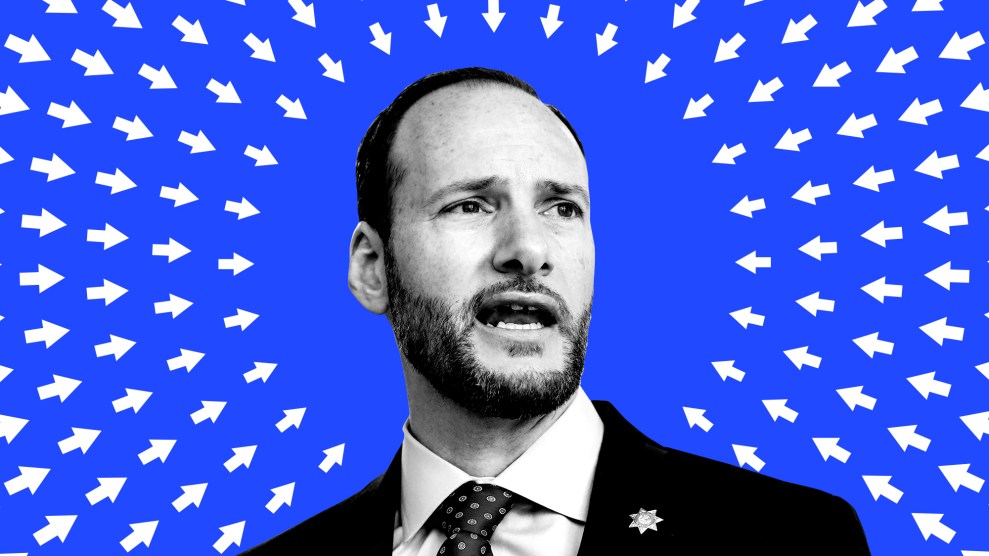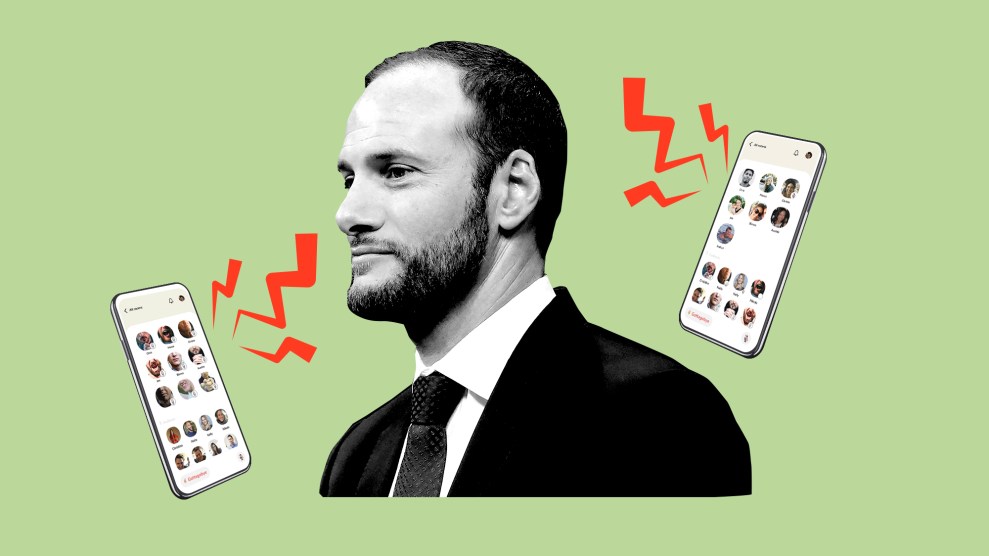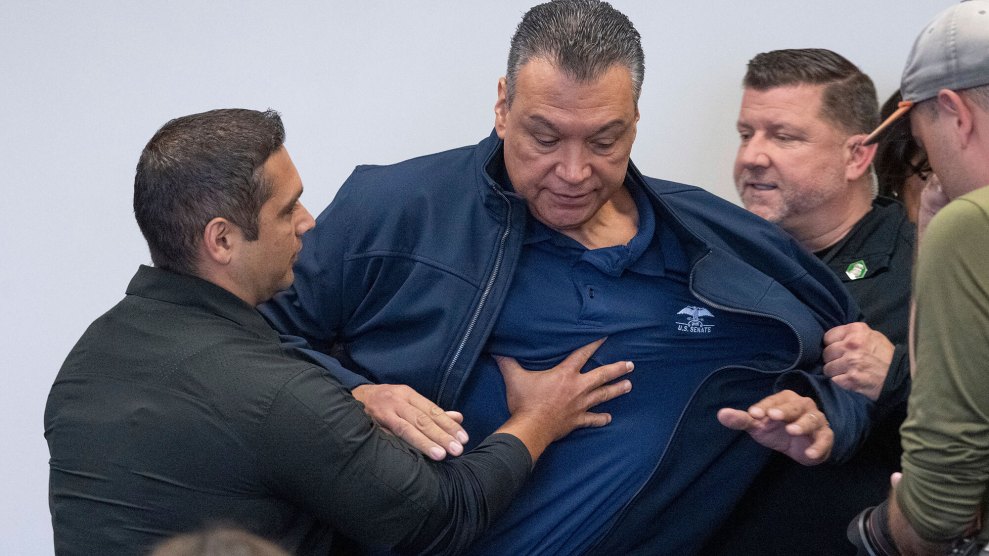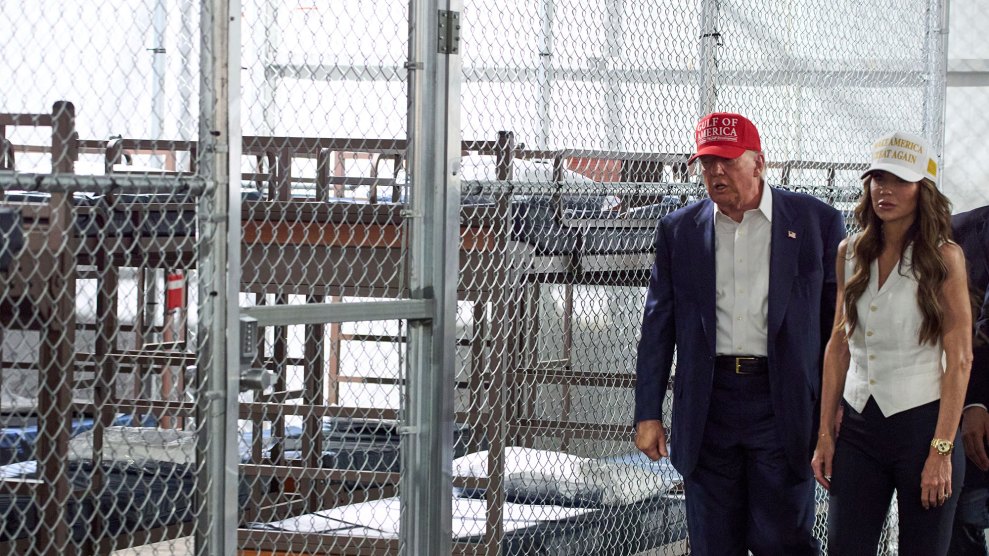
Mother Jones illustration; Gabrielle Lurie/San Francisco Chronicle/Getty
San Francisco is on the cusp of a historic recall election that could boot out one of the country’s most progressive district attorneys, Chesa Boudin, who took office in early 2020. Boudin, whose parents were incarcerated when he was just a baby, has rattled the establishment by trying to lower the city’s jail population and divert low-level offenders from prisons—changes that he says will, in the long run, keep the community safer. His critics, who include venture capitalists and a Republican billionaire, accuse him of turning San Francisco into a lawless Gotham City.
Their fight against Boudin is part of a broader tough-on-crime movement that has gained momentum during the pandemic. In Los Angeles, progressive District Attorney George Gascón faces a well-funded recall effort, too. Last year, so did multiple prosecutors in Virginia who campaigned on similar promises to make the legal system fairer for low-income people and people of color. In March, an Illinois lawmaker introduced a bill to recall reformist State’s Attorney Kim Foxx, accusing her of creating a “crisis of confidence in the Cook County judicial system.”
In all these places, “people are using fear narratives to paint a picture that reform and safety are opposite,” says Akhi Johnson, a former prosecutor who now works at the Vera Institute of Justice, a think tank that collaborates with progressive district attorneys. For instance, one anti-Boudin group in San Francisco wrote recently on its website that “as car break-ins, burglaries, and overdoses reach a crisis level in San Francisco, Boudin’s refusal to hold serial offenders and drug dealers accountable is putting more of us at risk.” Fearmongering like this can be persuasive: A few polls suggest that a majority of San Francisco voters (between 57 and 68 percent) now want to oust Boudin in the recall, including many Democrats. (One poll, commissioned by Boudin’s supporters, suggested that 48 percent of voters want to recall him.)
Boudin’s critics say they feel unsafe under his leadership. But the thing is, while the pandemic has undoubtedly heightened existing crises around homelessness, drug use, and mental health in San Francisco and elsewhere, crime rates are not spiraling out of control, and there’s no evidence that Boudin or other DAs are responsible for the upticks that have occurred. In fact, academics who studied progressive prosecutors around the country found that their policies did not cause violence to rise. With less than two weeks until the votes are counted in San Francisco, here’s a breakdown of the most relevant research about crime rates, progressive prosecutors, and the link (or lack thereof) between the two.
Overall, crime is not rising in San Francisco.
Watching cable news or even walking along some San Francisco streets, you’d be forgiven for believing that crime has soared. Viral videos show sprawling homeless encampments, sidewalks littered with drug needles, and men stuffing their backpacks with stolen goods during smash-and-grab robberies. Assaults against Asian American elders have stoked fear, even encouraging some volunteers to launch their own citizen safety patrols.
We shouldn’t downplay these public safety problems, because most of them have multiple victims—from the people forced to sleep in the rain because of skyrocketing rents, to the Asian American grandmothers at risk of attack on their errands, to the children who walk past syringes on their way home from school. These problems began long before Boudin took office, but for many San Francisco residents, it seems like they’ve gotten worse in the last couple of years. According to local and national data, an overwhelming majority of San Franciscans, like a majority of Americans, believe crime rates have gone up. Some of them may be reacting to media reports about shootings or other acts of violence, says the Vera Institute’s Johnson: “The tragic incident sticks with them; the fear piece of it tends to latch on.”
But what does the data say? The short version is that crime did shift dramatically during the early months of the pandemic—in San Francisco and around the country. But today, as the city increasingly returns to pre-pandemic behavior and more people leave their homes to work and socialize, crime has also largely shifted back toward pre-pandemic levels in the city and the state. In other words, lawlessness has not gotten markedly worse under Boudin.
Let’s start with violent crime. Earlier this year, the San Francisco Chronicle analyzed police incident data to compare the city’s 2022 crime rates with rates during the previous four years. Police data isn’t perfect, since it only reflects crimes that are reported to the cops, but it’s some of the best information we have available. And contrary to what the viral videos might suggest, the paper found that overall violent crime in San Francisco had declined during the pandemic, hovering at its lowest point since 1985. From 2019 to 2021, according to an analysis by Mother Jones, rape, robbery, and assault in the city decreased by 45 percent (resulting in 185 fewer cases), 27 percent (846 fewer cases), and 6 percent (158 fewer cases), respectively. A far cry from Gotham.
Still, you might wonder about property crimes, which have long plagued San Franciscans. These thefts are more common in San Francisco than elsewhere in California—perhaps because of the massive wealth gaps in the city, with Silicon Valley millionaires living in close proximity to people who can’t afford rent. Some property crimes did get worse during the pandemic, like burglaries, which rose 52 percent in the city in 2020 and stayed elevated in 2021. But as office buildings reopen and more workers return to the city this year, burglary rates are also returning to normal. And overall, property crime in the city dropped by about 11 percent from 2019 to 2021, according to police data. One exception to that trend: car thefts, which continue at a fast clip. But that’s not unique to San Francisco. Researcher Magnus Lofstrom of the Public Policy Institute of California told the Chronicle that cities nationally are experiencing more motor vehicle thefts than before the pandemic, potentially because the price of used cars spiked, giving thieves a greater incentive.
It’s possible, as some Boudin critics assert, that police data does not accurately reflect the true levels of property crime in the city: Many people don’t bother dialing 911 when their Amazon package gets snatched from their porch. But that’s always been true, even before Boudin came to office.
What is new, however, is that cops appear to be making fewer arrests for these types of crimes than they used to. In fact, the police clearance rate in San Francisco has dropped to its lowest in a decade, at just 8.1 percent. Some officers say they see no point bringing a suspect to the station because they believe Boudin is unlikely to pursue the case. (They’re wrong—more on that later.) Earlier this month, Boudin said his office had to go so far as renting a U-Haul to bust a boba shop that was accused of fencing stolen goods, after the police allegedly declined to help.
Homicides are up in SF, but not as much as they are in most big cities—including Republican-led ones.
Homicides are another exception to the trend of falling crime. Murders rose by an estimated 30 percent nationally during 2020—the biggest single-year increase on record. And they rose in San Francisco, too, by about 36 percent between 2019 and 2021. Most were from shootings.
We shouldn’t downplay these numbers either, because each death represents someone who didn’t make it home to their families, disproportionately in communities of color. Some criminologists speculate that the pandemic played a role, as the economic downturn made it hard for people to find stable work that can keep them from crime, and as more people purchased guns and struggled with their mental health. Other academics suspect that growing distrust of police exacerbated the situation, with people taking disputes into their own hands rather than deferring to law enforcement.
But again, let’s put the data in perspective. In San Francisco, the 36 percent spike in homicides equates to 15 additional homicides in 2021 compared with the year before the pandemic, when there were a total of 41 homicides. Even with that uptick, San Francisco has one of the lowest homicide rates of all major cities in the United States—roughly six killings per 100,000 people last year, compared with 10 per 100,000 in the similarly populated Washington, DC.
San Francisco’s gun violence rate also pales in comparison to that of some rural areas, including those with more traditional, tough-on-crime district attorneys. In one recent study, the think tank Third Way found that murder rates were a whopping 40 percent higher on average in the 25 states that voted for Donald Trump in the last election compared with states that voted for President Biden. “For example,” the report’s authors note, “Jacksonville, a city with a Republican mayor, had 128 more murders in 2020 than San Francisco, a city with a Democrat mayor, despite their comparable populations. In fact, the homicide rate in Speaker Nancy Pelosi’s San Francisco was half that of House Republican Leader Kevin McCarthy’s Bakersfield, a city with a Republican mayor that overwhelmingly voted for Trump. Yet there is barely a whisper, let alone an outcry, over the stunning levels of murders in these and other places.”
“If there’s an uptick in certain types of crime, it’s immediately blamed on DAs pursuing reforms,” adds the Vera Institute’s Johnson. “However, where DAs are continuing to pursue tough-on-crime tactics and crime is going up, the same questions are not asked of them.”
Boudin is not the first DA to try lowering the prison population.
When Boudin took office in early 2020, he made national headlines for some of his bold, unorthodox policies. A couple of weeks into his tenure, he announced that his prosecutors would no longer seek cash bail, because he argued the cash-bail system unfairly keeps low-income people in jail before their trials, whether or not they’re innocent. For certain low-level crimes, he also began diverting more offenders to alternative programs like mental health and substance abuse treatment, rather than trying to incarcerate them.
Boudin, however, is not the first district attorney to experiment with similar policies—not nationally, and not in San Francisco. His predecessor George Gascón also tried to lower jail and prison populations in the city before moving to Los Angeles. And it’s not like Boudin isn’t going after any crimes, especially more serious ones. According to a San Francisco Chronicle review, he’s prosecuting a greater percentage of homicide and narcotics cases than Gascón did, and a lower percentage of petty theft cases. His overall charging rate was 48 percent, just six percentage points lower than Gascon’s rate in 2018 and 2019 and about the same as Gascón’s rate in 2016 and 2017. (Boudin says the pandemic is partly responsible for the slight differences in his charging and conviction rates: The coronavirus forced courts to close, slowing down trials. Plus, new California laws allowed more people to be diverted from the prison system to alternative treatment programs.)
Outside California, other district attorneys have pursued similar goals for years. In Illinois, Cook County State’s Attorney Kim Foxx has tried to reduce the incarcerated population since she was elected in 2016, long before Boudin started campaigning. Like Boudin and Gascón, she supports banning cash bail and has made changes to keep fewer people in jail before trial, while also prioritizing diversion programs. Philadelphia District Attorney Larry Krasner, who took office in 2018, campaigned on similar promises and has likewise sought shorter sentences for certain offenses. From Brooklyn to Austin to New Orleans, other prosecutors are following their lead.
Similar DAs elsewhere have not caused jumps in violence.
In fact, as far as crime levels go, some of these DAs appear to be performing better than their more conservative district attorney peers, according to recent research by academics. That’s good news for anyone who worries about the future of public safety under Boudin.
For example, University of Oxford professor Christopher Stone recently examined levels of violence in Brooklyn, Chicago, St. Louis, and Philadelphia—cities where progressive chief prosecutors have worked since 2014, 2016, 2017, and 2018, respectively. “Not only had violent crime not risen more under progressive prosecutors than under the old guard, but in every place I looked the progressive prosecutors were presiding over greater reductions or smaller increases in violent crime than in their surrounding counties,” he wrote in January.
In another series of studies, three economics and politics scholars from Texas A&M University, Rutgers University, and NYU noticed that some prosecutors in the Boston area were more lenient than others, dismissing certain misdemeanor cases rather than pursuing charges, in a style that mirrors that of progressive district attorneys. Using countywide data from 2000 to 2018, the researchers wanted to find out what happened to the “lucky” defendants who faced dismissive prosecutors, and whether their lack of punishment incentivized them to commit more crimes in the next couple of years. It didn’t. Instead, these defendants were 58 percent less likely to be arrested for another crime than other people who were charged by stricter prosecutors for the same original offense.
“There are public safety benefits to being more lenient, especially toward first-time nonviolent misdemeanor defendants,” says Jennifer Doleac, an associate professor of economics at Texas A&M who co-wrote the study along with Amanda Agan of Rutgers and Anna Harvey of NYU. One possible reason why prosecuting someone could make them more likely to get rearrested later is that it can disrupt their lives, forcing them to take time off work for hearings and contributing to mental distress. And for those who are convicted, a criminal record might make it harder to find employment or housing.
The same trio of scholars then examined crime rates after former District Attorney Rachael Rollins took office in Boston’s Suffolk County in 2019. As a progressive, she wanted to mostly stop prosecuting a list of 15 nonviolent misdemeanors, things like trespassing and drug possession. “We found no evidence that this policy change resulted in a rise in crime,” Doleac wrote recently. Doleac and her colleagues are now studying whether those results hold true in other places, and so far they appear to: In 35 urban districts around the country, the researchers found, crime rates did not increase after prosecutors implemented progressive reforms like pursuing less pretrial detention, more diversion from jail, and less prosecution of minor offenses.
Meanwhile, Fordham University criminologist John Pfaff recently examined murder rates in 69 jurisdictions in 2020 and found that they were all almost equal regardless of whether a progressive prosecutor or a more traditional prosecutor was in charge. Put another way, the homicide wave has touched just about every part of America, from red states to blue, from rural towns to big cities. “In short, the best evidence so far…implies that progressive prosecutors’ reforms are not the cause of rising homicide and shooting rates,” Doleac wrote of her research. “[T]heir current policies do not appear to be doing any harm—and in some cases appear to be doing substantial good.”
Maybe these DAs need more time, not less.
As San Franciscans decide whether to recall Boudin and cut his time short, the science seems to suggest that he and other progressive DAs have not had a big impact on short-term crime rates. It’s worth imagining, says the Vera Institute’s Johnson, what kind of effect these attorneys might have on long-term crime rates, years down the road, if given a chance to keep working. “These DAs are looking for long-term solutions,” he says.
Investing in people’s housing, education, mental health, and substance abuse treatment helps communities create conditions to be safer over time. Plus, when prosecutors go softer on low-level offenses, it frees up more resources to focus on solving homicides, rapes, and other crimes that are more costly to society.
Districts around the country have already let tough-on-crime prosecutors and politicians lead for decades. These officials helped lay the groundwork for the current moment, neglecting to build a social safety net that could keep people adequately secure during a pandemic, and investing heavily in police departments and prisons (where viruses spread like wildfire). Boudin, on the other hand, took office less than three years ago. What might he and other progressive DAs accomplish if, rather than fighting recall elections, they were given the same amount of time to prove themselves?
The progressive prosecutor movement “is a relatively new shift, for the most part,” says Doleac of Texas A&M, noting that some reformer DAs began working shortly before the pandemic. She hopes to study the long-term effects of their policies—assuming they can get reelected. “It’s something that I and other people will be watching, for sure. We’re just gonna need more time, that’s the bottom line.”

















